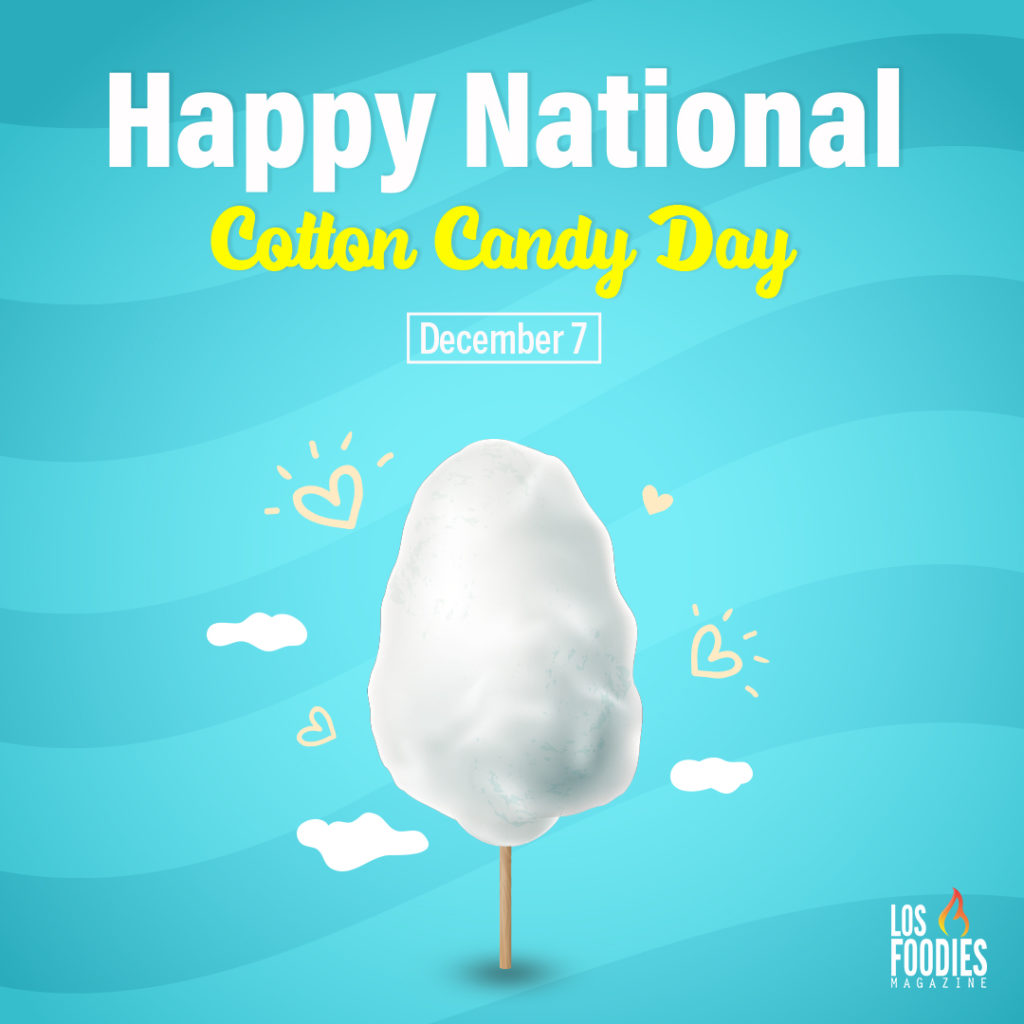Do you have a sweet tooth? If so, you’re going to love National Cotton Candy Day! You may think that the only type of people who don’t love National Cotton Candy Day is the dentists of the world!
However, you may be surprised to learn that it was dentists who invented cotton candy, to begin with. Back in the day, it was known as fairy floss. Today, it is the go-to snack when going to a county fair. For most people, their childhood memories would simply be incomplete without this sugary delightful treat.
Over the past 120 years, cotton candy has grown from a small town treat into a global phenomenon. It has a special place in our hearts because eating it often brings us back to childhood memories of good times and nostalgia. Cotton candy has been putting smiles on people’s faces since the late 1800s and has, over 100 years after its invention, become a staple in American culture.

Cotton candy as we know it was first created in 1897 when a dentist named William Morrison joined forces with a confectioner by the name of John C. Wharton. Together, the duo created a machine that spun heated sugar through a screen, creating the floss-like texture that we all know and love.
It would take Morrison and Wharton seven years to share their new product with the general public.
Finally, in 1904, Morrison and Wharton became entrepreneurs when they debuted their new sugary treat at the St. Louis World Fair. Over 20 million people visited the fair during its run from April to December, and to Morrison and Wharton’s delight, many of the fair-goers were intrigued by the sugary treat known then as “fairy floss.”
Morrison and Wharton sold boxes of cotton candy for a quarter each to fair-goers.
The treat was so popular that, by the end of the fair, over 68,000 boxes of cotton candy were sold. Morrison and Wharton made just over $17,000 from their foray into the world of confectionary.
That would be worth just over half a million dollars in today’s economy! Not bad for only working eight months, right?
After selling cotton candy at the St. Louis World Fair, Morrison and Wharton continued their business selling cotton candy to friends and clients in their native Tennessee.
Later on, they began to market both the machine and the candy in newspapers such as the New York Times.
With an updated, cheaper price of 5 to 10 cents a box, “fairy floss” had taken America by storm. People wanting to make the treat themselves could purchase a hand-made machine directly from the “Electric Candy Company”—the corporation that Morrison and Wharton started in order to bring “fairy floss” to the masses.
Another change to the development of cotton candy came in 1949 with the introduction of the spring-loaded base by a company in Ohio called Gold Medal Products.
The original cotton candy machine created by Morrison and Wharton often broke down, but when it was operational, the machine tended to shake and was extremely noisy.
The spring-loaded base introduced by Gold Medal Products not only made the rotating part of the machine more stable, but it also increased the reliability of the machine.
The spinning components that are essential to making the texture of cotton candy so fluffy broke down less often, which meant that cotton candy production could increase
When Morrison and Wharton invented their new cotton candy machine, they immediately filed for patent protection of the device.
Due to patent law, other people wanting to capitalize on the success of “fairy floss” would have to wait until Morrison and Wharton’s patent ran out or buy the machine directly from the two original inventors.
Because of Morrison and Wharton’s patent, “fairy floss” really didn’t change much in the early 1900s: if you made or enjoyed cotton candy, you had to do it using an official machine from Morrison and Wharton. Competitors were only allowed to move into the market in 1921, almost 25 years after the first invention of cotton candy.
New competitors brought new changes to the world of cotton candy. Some of the first changes to the cotton candy industry came in the 1920s after the 17-year patent protection for Morrison and Wharton’s “electric candy machine” finally expired.
In 1921, another dentist by the name of Josef Lascaux broke into the cotton candy scene. After Lascaux saw the success of fellow dentist Morrison, Lascaux decided that he also wanted to make the treatment for his dental clients.
So Lascaux created a cotton candy machine similar in design to Morrison and Wharton’s contraption.
However, in order to avoid association with the original “fairy floss” created by Morrison and Wharton, Lascaux decided to market his version of the treat as “cotton candy.” He thought that the treat looked like the cotton grown in Louisiana, the state he resided in. Cotton candy is almost 70% air, so it makes sense that Lascaux coined the treat after cotton.
The decade of the 1920s was significant in the history of cotton candy since this was the time that everyone started calling “fairy floss” by the name we know this treat today: “cotton candy.”
A cultural shift had occurred and the name Lascaux coined ended up becoming the permanent name that we all use today (Australia seems to be the only country that held on the original name of “fairy floss”).
Celebrate National Cotton Candy Day by getting your favorite flavor and sharing it with friends. Ok, we’re just kidding, don’t share it, just eat it up until you can’t eat another bite, and write your dentist an apology note. Or, given that a dentist invented it, perhaps it’s you who deserves the apology note, hmm?
There are so many fun activities that you can try on National Cotton Candy Day. Of course, the goal is to always eat some cotton candy! But how about making your own? There are a lot of great recipes online that you can follow.
Typically, you are going to need some food coloring, flavored extracts such as raspberry extract, salt, water, corn syrup, and sugar. Recipes can differ, but these are the sort of ingredients you are going to need. You can have fun experimenting with your own candy floss recipes, and even more, fun when you eat them afterward.
There are lots of exciting dessert recipes that call for the use of candy floss as well. This includes everything from cotton candy s’mores to cotton candy donuts and cupcakes! Sounds pretty delicious, right? The suggestions don’t end there either! You can make fairy floss whoopie pies, fairy floss ice cream sundaes, and much more!
Or, how about creating your own candy floss cocktail? There are lots of delicious options here too! This includes cotton candy champagne cocktails, prosecco, gin candy floss cocktails, and fairy floss martinis. There is something for everyone. Plus, if you are having friends around these sorts of drinks are certainly going to impress.

The Los Foodies Magazine content team is dedicated to showcasing New Mexico’s food culture through stories, recipes, events, and local business features. They create engaging content that connects readers with the chefs, restaurants, and flavors that define the community.
View all posts Los Foodies Magazine Content Team